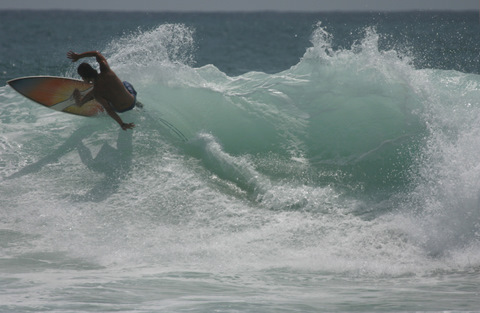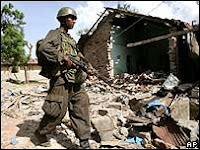“All we hear is war,” says Tavakumar, a 43-year-old rebel who only uses one name, patrolling a road a few miles (several kilometers) from the front. “I’m ready to fight.”
Five years after a cease-fire brought a measure of relief to Sri Lanka, a ferocious ethnic war is again raging between the government dominated by the country’s predominantly Buddhist Sinhalese majority and the Tamil Tigers, separatists seeking a homeland for the largely Hindu Tamil minority.
The signs of a deepening conflict are everywhere: soldiers in full battle gear patrolling Colombo, the increasingly fortified capital; sandbagged bunkers and trenches going up all over the rebel-held north.
Both sides claim to be observing the truce, which remains officially in place. But clearly it has left neither side satisfied, and now it has completely collapsed. The rebels are mounting renewed attacks, including a bus bombing last June that killed 64 people, and Sri Lankan forces are pushing farther into rebel territory, with officials openly saying they aim to militarily crush their enemy.
“We want to destroy them, the Tiger bases, all these things,” Defense Secretary Gotabhaya Rajapakse told The Associated Press in an interview. Rajapakse, brother of President Mahinda Rajapakse, survived a Tamil suicide bombing of his motorcade in December.
Amid the spiraling violence, the AP secured permission to cross the front lines and make the first visit by foreign journalists to insurgent territory since the war reignited in August.
In Kilinochchi, the main rebel-held city, the cease-fire seemed a distant notion as a pair of warplanes dropped flares to light up a rebel mortar position in the jungles beyond town. Farmers and insurgents scrambled into dank, makeshift bomb shelters as the jets dropped their bombs, obliterating a rebel mortar position.
Nineteen years of suicide bombings, jungle clashes, torture and village massacres, from 1983 until the truce was signed in 2002, took an estimated 65,000 lives on this West Virginia-sized island of 20 million people off India’s southern tip.
Since August, about 3,000 more have been killed and 160,000 displaced, most in eastern Sri Lanka where the government has plowed through relatively lightly defended rebel territory.
Next up, officials say, is the rebels’ heavily fortified northern heartland, a would-be Tamil state of about 500,000 people with courts, traffic cops, a forestry department and a legal code that bans adultery and pornography.
It’s territory the rebels say they’ll defend with everything they’ve got.
“The fighting in the north is going to be more intense and the (rebels) probably won’t withdraw,” as they did in the east, said Jehan Perera of Sri Lanka’s National Peace Council, a think tank. “Battlefield losses will be heavier.”
There’s also growing concern about the rise in human rights violations. The rebels and government allied militias are both alleged to have abducted A?a??a?? and in some cases killed A?a??a?? hundreds of civilians, and there are well-documented cases of top government officials threatening critics of the war, especially journalists.
The roots of the conflict stretch back to the years after independence from Britain in 1948, when the government gave Buddhism a prominent role and declared Sinhala the sole official language.
The result was widespread discrimination against Tamils, until war broke out in 1983.
The 2002 cease-fire negotiated by Norwegian diplomats raised hopes which were reinforced two years later by a belief that the Indian Ocean tsunami would force the warring sides to work together for national recovery. But by late 2005, sporadic shootings and bombings were back. Most A?a??a?? such as a bus bombing that killed 64 people in June A?a??a?? were blamed on the Tigers, who many believed were trying to force the government to make concessions at the negotiating table.
If that was their strategy, it backfired spectacularly.
Mahinda Rajapakse had been elected president in late 2005 in part by Sinhalese hard-liners who viewed the cease-fire as a betrayal. In August, he opted for all-out war, while claiming to be honoring the cease-fire and only responding to rebel provocations.
He is being cheered on by hard-line Buddhist monks who see themselves as guardians of the island’s Sinhalese culture, and, increasingly, by many ordinary Sinhalese. A recent poll by Colombo’s respected Center for Policy alternatives found nearly 60 percent of the Sinhalese supported a military solution.
source:
http://www.iht.com/articles/ap/2007/05/06/asia/AS-FEA-GEN-Sri-Lanka-At-War-Again.php




 By Wilson Gnanadass in Pottuvil
By Wilson Gnanadass in Pottuvil




 Arugam Forum
Arugam Forum Arugam Photo Galleries on Picasa
Arugam Photo Galleries on Picasa Old Website
Old Website Press Coverage
Press Coverage Surf Forecast for Arugam Bay
Surf Forecast for Arugam Bay
TODAY’s Comments